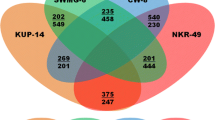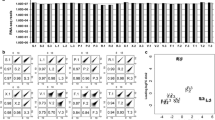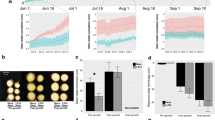Abstract
Suitability of wood biomass for pulp production is dependent on the cellular architecture and composition of secondary cell wall. Presently, systems genetics approach is being employed to understand the molecular basis of trait variation and co-expression network analysis has enabled holistic understanding of complex trait such as secondary development. Transcription factors (TFs) are reported as key regulators of meristematic growth and wood formation. The hierarchical TF network is a multi-layered system which interacts with downstream structural genes involved in biosynthesis of cellulose, hemicelluloses and lignin. Several TFs have been associated with wood formation in tree species such as Populus, Eucalyptus, Picea and Pinus. However, TF-specific co-expression networks to understand the interaction between these regulators are not reported. In the present study, co-expression network was developed for TFs expressed during wood formation in Eucalyptus tereticornis and ethylene-responsive element-binding factor, EtERF2, was identified as the major hub transcript which co-expressed with other secondary cell wall biogenesis-specific TFs such as EtSND2, EtVND1, EtVND4, EtVND6, EtMYB70, EtGRAS and EtSCL8. This study reveals a probable role of ethylene in determining natural variation in wood properties in Eucalyptus species. Understanding this transcriptional regulation underpinning the complex bio-processing trait of wood biomass will complement the Eucalyptus breeding program through selection of industrially suitable phenotypes by marker-assisted selection.



Similar content being viewed by others
References
Ambavaram MM, Krishnan A, Trijatmiko KR, Pereira A (2011) Coordinated activation of cellulose and repression of lignin biosynthesis pathways in rice. Plant Physiol 155:916–931
Andersson-Gunnerås S, Hellgren JM, Björklund S, Regan S, Moritz T, Sundberg B (2003) Asymmetric expression of a poplar ACC oxidase controls ethylene production during gravitational induction of tension wood. Plant J 34:339–349
Andersson-Gunnerås S, Mellerowicz EJ, Love J, Segerman B, Ohmiya Y, Coutinho PM, Nilsson P, Henrissat B, Moritz T, Sundberg B (2006) Biosynthesis of cellulose-enriched tension wood in Populus: global analysis of transcripts and metabolites identifies biochemical and developmental regulators in secondary wall biosynthesis. Plant J 45:144–165
Barros E, Staden CA, Lezar S (2009) A microarray-based method for the parallel analysis of genotypes and expression profiles of wood-forming tissues in Eucalyptus grandis. BMC Biotechnol 9(51):1472–6750
Basnet RK, Carpio DPD, Xiao D, Bucher J, Jin M, Boyle K, Fobert P, Visser RGF, Maliepaard C, Bonnema G (2016) A systems genetics approach identifies gene regulatory networks associated with fatty acid composition in Brassica rapa seed. Plant Physiol 170:568–585
Baute J, Herman D, Coppens F, De Block J, Slabbinck B, Dell’Acqua M, Pè ME, Maere S, Nelissen H, Inzé D (2016) Combined large-scale phenotyping and transcriptomics in maize reveals a robust growth regulatory network. Plant Physiol 170:1848–1867
Cassan-Wang H, Goue N, Saidi MN, Legay S, Sivadon P, Goffner D, Grima-Pettenati J (2013) Identification of novel transcription factors regulating secondary cell wall formation in Arabidopsis. Front Plant Sci 4:189
De Maeyer D, Weytjens B, De Raedt L, Marchal K (2016) Network-based analysis of eQTL data to prioritize driver mutations. Genome Biol Evol 8:481–494
Dharanishanthi V, Ghosh Dasgupta M (2016) Construction of co-expression network based on natural expression variation of xylogenesis-related transcripts in Eucalyptus tereticornis. Mol Biol Rep 43:1129–1146
Du J, Groover A (2010) Transcriptional regulation of secondary growth and wood formation. J Integr Plant Biol 52:17–27
Du S, Yamamoto F (2003) Ethylene evolution changes in the stems of Metasequoia glyptostroboides and Aesculus turbinata seedlings in relation to gravity-induced reaction wood formation. Trees Struct Funct 17:.522–528
Du S, Yamamoto F (2007) An overview of the biology of reaction wood formation. J Integr Plant Biol 49:131–143
Du Q, Gong C, Wang Q, Zhou D, Yang H, Pan W, Li B, Zhang D (2016) Genetic architecture of growth traits in Populus revealed by integrated quantitative trait locus (QTL) analysis and association studies. New Phytol 209:1067–1082
Etchells JP, Provost CM, Turner SR (2012) Plant vascular cell division is maintained by an interaction between PXY and ethylene signalling. PLoS Genet 8:e1002997
Felten J, Sundberg B (2013) Biology, chemistry and ultrastructure of tension wood. In: Fromm J (ed) Cellular aspects of wood formation. Springer, Berlin, pp 203–224
Felten J, Vahala J, Love J, Gorzsás A, Gerber L, Kumar M, Kangasjärvi J, Sundberg B (2011) Ethylene signaling via ethylene response factors (ERFs) modifies wood development in hybrid aspen. BMC Proc 5:115
Felten J, Vahala J, Love J, Gorzsas A, Ruggeberg M, Delhomme N et al (2018) Ethylene signaling induces gelatinous layers with typical features of tension wood in hybrid aspen. New Phytol. https://doi.org/10.1111/nph.15078
Feltus FA (2014) Systems genetics: a paradigm to improve discovery of candidate genes and mechanisms underlying complex traits. Plant Sci 223:45–48
Goicoechea M, Lacombe E, Legay S, Mihaljevic S, Rech P, Jauneau A, Lapierre C, Pollet B, Verhaegen D, Chaubet-Gigot N, Grima-Pettenati J (2005) EgMYB2, a new transcriptional activator from Eucalyptus xylem, regulates secondary cell wall formation and lignin biosynthesis. Plant J 43:553–567
Groover AT, Nieminen K, Helariutta Y, Mansfield SD (2010) Wood formation in Populus. In: Jansson S, Bhalerao RP, Groover AT (eds) Genetics and genomics of Populus. Springer, New York, pp 201–224
Hefer CA, Mizrachi E, Myburg AA, Douglas CJ, Mansfield SD (2015) Comparative interrogation of the developing xylem transcriptomes of two wood-forming species: Populus trichocarpa and Eucalyptus grandis. New Phytol 206(4):1391–1405
Hussey SG, Mizrachi E, Spokevicius AV, Bossinger G, Berger DK, Myburg AA (2011) SND2, a NAC transcription factor gene, regulates genes involved in secondary cell wall development in Arabidopsis fibres and increases fibre cell area in Eucalyptus. BMC Plant Biol 11:173
Hussey SG, Mizrachi E, Creux NM, Myburg AA (2013) Navigating the transcriptional roadmap regulating plant secondary cell wall deposition. Front Plant Sci 4:1–21
Ingemarsson BSM (1995) Ethylene effects on peroxidases and cell growth patterns in Picea abies hypocotyl cuttings. Physiol Plant 94:211–218
Ingvarsson PK, Street NR (2011) Association genetics of complex traits in plants. New Phytol 189:909–922
Jia P, Zhao Z (2014) Network assisted analysis to prioritize GWAS results: principles, methods and perspectives. Hum Genet 133:125–138
Jokipii-Lukkari S, Delhomme N, Schiffthaler B, Mannapperuma C, Prestele J, Nilsson O, Street NR, Tuominen H (2018) Transcriptional roadmap to seasonal variation in wood formation of Norway Spruce. Plant Physiol 176:2851–2870
Kanehisa M, Goto S (2000) KEGG: kyoto encyclopedia of genes and genomes. Nucleic Acids Res 28:27–30
Kanehisa M, Goto S, Sato Y, Furumichi M, Tanabe M (2012) KEGG for integration and interpretation of large-scale molecular data sets. Nucleic Acids Res 40(D1):D109–D114
Kirst M, Basten CJ, Myburg AA, Zeng ZB, Sederoff RR (2005) Genetic architecture of transcript-level variation in differentiating xylem of a Eucalyptus hybrid. Genetics 169:2295–2303
Lamara M, Raherison E, Lenz P, Beaulieu J, Bousquet J, MacKay J (2016) Genetic architecture of wood properties based on association analysis and co-expression networks in white spruce. New Phytol 210:240–255
Legay S, Sivadon P, Blervacq AS, Pavy N, Baghdady A, Tremblay L et al (2010) EgMYB1, an R2R3 MYB transcription factor from eucalyptus negatively regulates secondary cell wall formation in Arabidopsis and poplar. New Phytol 188:774–786
Li E, Bhargava A, Qiang W, Friedmann MC, Forneris N, Savidge RA, Johnson LA, Mansfield SD, Ellis BE, Douglas CJ (2012) The Class II KNOX gene KNAT7 negatively regulates secondary wall formation in Arabidopsis and is functionally conserved in Populus. New Phytol 194:102–115
Liu Y, Wei M, Hou C, Lu T, Liu L, Wei H et al (2017) Functional characterization of populus PsnSHN2 in coordinated regulation of secondary wall components in tobacco. Sci Rep 7:42
Long TA, Benfey PN (2006) Transcription factors and hormones: new insights into plant cell differentiation. Curr Opin Cell Biol 18:710–714
Love J, Björklund S, Vahala J, Hertzberg M, Kangasjärvi J, Sundberg B (2009) Ethylene is an endogenous stimulator of cell division in the cambial meristem of Populus. Proc Natl Acad Sci USA 106:5984–5989
Ma R, Xiao Y, Lv Z, Tan H, Chen R, Li Q et al (2017) AP2/ERF Transcription Factor, Ii049, positively regulates lignan biosynthesis in Isatis indigotica through activating salicylic acid signaling and Lignan/Lignin pathway genes. Front Plant Sci 8:1361
McCarthy RL, Zhong R, Ye ZH (2009) MYB83 is a direct target of SND1 and acts redundantly with MYB46 in the regulation of secondary cell wall biosynthesis in Arabidopsis. Plant Cell Physiol 50:1950–1964
Mizrachi E, Myburg AA (2016) Systems genetics of wood formation. Curr Opin Plant Biol 30:94–100
Mizrachi E, Verbeke L, Christie N, Fierro AC, Mansfield SD, Davis MF, Gjersing E, Tuskan GA, Montagu MV, de Peer YV, Marchal K, Myburg AA (2017) Network-based integration of systems genetics data reveals pathways associated with lignocellulosic biomass accumulation and processing. Proc Natl Acad Sci 114:1195–1200
Negishi N, Nanto K, Hayashi K, Onogi S, Kawaoka A (2011) Transcript abundances of LIM transcription factor, 4CL, CAld5H and CesAs affect wood properties in Eucalyptus globulus. Silvae Genet 60:288–296
Ohashi-Ito K, Fukuda H (2010) Transcriptional regulation of vascular cell fates. Curr Opin Plant Biol 13:670–676
Phukan UJ, Jeena GS, Tripathi V, Shukla RK (2017) Regulation of apetala2/ethylene response factors in plants. Front Plant Sci. https://doi.org/10.3389/fpls.2017.00150
Porth I, Klápště J, Skyba O, Friedmann MC, Hannemann J, Ehlting J, El-Kassaby YA, Mansfield SD, Douglas CJ (2013) Network analysis reveals the relationship among wood properties, gene expression levels and genotypes of natural Populus trichocarpa accessions. New Phytol 200:727–742
Sakamoto S, Takata N, Oshima Y, Yoshida K, Taniguchi T, Mitsuda N (2016) Wood reinforcement of poplar by rice NAC transcription factor. Sci Rep 6:19925
Salazar MM, Nascimento LC, Camargo EL, Gonçalves DC, Lepikson Neto J, Marques WL, Teixeira PJ, Mieczkowski P, Mondego JM, Carazzolle MF, Deckmann AC, Pereira GA (2013) Xylem transcription profiles indicate potential metabolic responses for economically relevant characteristics of Eucalyptus species. BMC Genom 14:201
Schuetz M, Smith R, Ellis B (2013) Xylem tissue speciation, patterning and differentiation mechanisms. J Exp Bot 64:11–31
Seyfferth C, Wessels B, Jokipii-Lukkari S, Sundberg B, Delhomme N, Felten J, Tuominen H (2018) Ethylene-related gene expression networks in wood formation. Front Plant Sci 9:272
Shannon P, Markiel A, Ozier O, Baliga NS, Wang JT, Ramage D, Amin N, Schwikowski B, Ideker T (2003) Cytoscape: a software environment for integrated models of biomolecular interaction networks. Genome Res 13:2498–2504
Shi R, Wang JP, Lin YC, Li Q, Sun YH, Chen H, Sederoff RR, Chiang VL (2017) Tissue and cell-type co-expression networks of transcription factors and wood component genes in Populus trichocarpa. Planta 245:927–938
Shinya T, Iwata E, Nakahama K, Fukuda Y, Hayashi K, Nanto K, Rosa AC, Kawaoka A (2016) Transcriptional profiles of hybrid Eucalyptus genotypes with contrasting lignin content reveal that monolignol biosynthesis-related genes regulate wood composition. Front Plant Sci 7:443
Soler M, Plasencia A, Larbat R, Pouzet C, Jauneau A, Rivas S, Pesquet E, Lapierre C, Truchet I, Grima-Pettenati J (2017) The Eucalyptus linker histone variant EgH1.3 cooperates with the transcription factor EgMYB1 to control lignin biosynthesis during wood formation. New Phytol 213:287–299
Sundell D, Street NR, Kumar M, Mellerowicz EJ, Kucukoglu M, Johnsson C et al (2017) AspWood: high-spatial-resolution transcriptome profiles reveal uncharacterized modularity of wood formation in Populus tremula. Plant Cell 29:1585–1604
Thavamanikumar S, Southerton S, Thumma B (2014) RNA-Seq using two populations reveals genes and alleles controlling wood traits and growth in Eucalyptus nitens. PLoS One 9:e101104
Vahala J, Felten J, Love J, Gorzsas A, Gerber L, Lamminmaki A, Kangasjarvi J, Sundberg B (2013) A genome-wide screen for ethylene-induced ethylene response factors (ERFs) in hybrid aspen stem identifies ERF genes that modify stem growth and wood properties. New Phytol 200:511–522
Vanholme R, Storme V, Vanholme B, Sundin L, Christensen JH, Goeminne G, Halpin C, Rohde A, Morreel K, Boerjan W (2012) A systems biology view of responses to lignin biosynthesis perturbations in Arabidopsis. Plant Cell 24:3506–3529
Verbeke LP, Cloots L, Demeester P, Fostier J, Marchal K (2013) EPSILON: An eQTL prioritization framework using similarity measures derived from local networks. Bioinformatics 29:1308–1316
Wang HZ, Dixon RA (2012) On–off switches for secondary cell wall biosynthesis. Mol Plant 5:297–303
Xu T, Ma T, Hu Q, Liu J (2015) An integrated database of wood-formation related genes in plants. Sci Rep. https://doi.org/10.1038/srep11422
Ye ZH, Zhong R (2015) Molecular control of wood formation in trees. J Exp Bot 66:4119–4131
Yu H, Soler M, San Clemente H, Mila I, Paiva JA, Myburg AA, Bouzayen M, Grima-Pettenati J, Cassan-Wang H (2015) Comprehensive genome-wide analysis of the Aux/IAA gene family in Eucalyptus: evidence for the role of EgrIAA4 in wood formation. Plant Cell Physiol 56:700–714
Zhang X, Cal AJ, Borevitz JO (2011) Genetic architecture of regulatory variation in Arabidopsis thaliana. Genome Res 21:725–733
Zhang J, Nieminen K, Serra JAA, Helariutta Y (2014) The formation of wood and its control. Curr Opin Plant Biol 17:56–63
Zhong R, Ye ZH (2014) Transcriptional regulation of biosynthesis of cell wall components during Xylem differentiation. In: Fukuda H (ed) Plant cell wall patterning and cell shape. Wiley, Hoboken, pp 351–377
Zhong R, Lee C, Ye ZH (2010) Evolutionary conservation of the transcriptional network regulating secondary cell wall biosynthesis. Trends Plant Sci 15:625–632
Zinkgraf M, Gerttula S, Groover A (2017) Transcript profiling of a novel plant meristem, the monocot cambium. J Integr Plant Biol 59:436–449
Acknowledgements
We acknowledge the guidance given by Dr. Jennifer Dewoody, National Forest Genetics Laboratory, USDA Forest Service, Placerville, CA; Dr. Sucheta Tripathy, Structural Biology and Bio-informatics Division, Indian Institute of Chemical Biology, Kolkata, India; Dr. Saravanakumar Selvaraj, Centre for Pharmacology and Toxicology, Hannover Medical School, Hannover, Germany, and Dr. Gayatri Ramakrishnan, Molecular Biophysics Unit, Indian Institute of Science, Bangalore, India, for developing gene regulatory networks. The funding for the research work was provided to Dr. Modhumita Ghosh Dasgupta by Department of Biotechnology, Government of India, under the research project with grant number BT/PR10055/PBD/16/772/2007. The funding support as research fellowship was provided to Dr. Veeramuthu Dharanishanthi by Department of Biotechnology, Government of India.
Author information
Authors and Affiliations
Corresponding author
Ethics declarations
Conflict of interest
On behalf of all authors, the corresponding author states that there is no conflict of interest.
Electronic supplementary material
Below is the link to the electronic supplementary material.
Rights and permissions
About this article
Cite this article
Dharanishanthi, V., Ghosh Dasgupta, M. Co-expression network of transcription factors reveal ethylene-responsive element-binding factor as key regulator of wood phenotype in Eucalyptus tereticornis. 3 Biotech 8, 315 (2018). https://doi.org/10.1007/s13205-018-1344-6
Received:
Accepted:
Published:
DOI: https://doi.org/10.1007/s13205-018-1344-6




